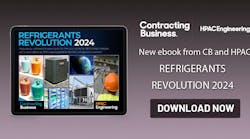The foundation of a building's heat-transfer strategy, the cooling-tower specification cannot be undone during construction. The best tower is not necessarily the one that proved successful on the last project, but the one promising the lowest energy and maintenance costs, the most reliability, and the longest life for the project at hand.
As requirements for buildings become more stringent, so do those for cooling towers. Read on for ways to keep your cooling-tower planning and specifying up to date.
The first decision to be made in cooling-tower selection concerns the choice of an open- or a closed-tower design. Simply stated, in a closed cooling tower, or “fluid cooler,” cooling water is circulated through a tube bundle, which is sprayed with water from an independent circulating pump. In an open cooling tower, cooling water is sprayed over a fill, through which air is blown. Put another way, a closed cooling tower is an air-to-fluid heat exchanger augmented by spray water and forced airflow, while an open cooling tower is a fountain that cools fluid directly through evaporation.
The chief advantage of a closed cooling tower is that it isolates cooling water from contaminants in outside air. An open cooling tower does just the opposite: It scrubs contaminants from outside air and puts them into cooling water, which is circulated through cooled equipment (i.e., chiller condenser barrels).
In terms of first cost per British thermal unit transferred, open cooling towers win every time. In terms of life-cycle cost, however, closed cooling towers narrow the gap and usually exceed the performance of open cooling towers. By exposing heat-transfer surfaces to more closely controlled water chemistry, closed cooling towers provide more uniform performance in the long run and reduce the fouling of heat-exchange surfaces. Also, they allow effective cooling during subfreezing outdoor conditions.
Two trends have impacted the application of cooling towers over the past decade:
- Buildings are getting larger and are better-sealed against the weather.
- Buildings contain more voice-data processing equipment.
As a result of these trends, there is demand for cooling all year long, even at the depths of a northern winter. When a building needs cooling at 0 F, the control of ice in an open tower begins to outweigh the tower's increased efficiency at above-freezing temperatures. A lot of the first- and energy-cost savings of open towers can be negated by the cost of repairing freeze damage. A closed tower, on the other hand, operates well amid freezing temperatures with a drained spray basin and little or no airflow from the fan, becoming a dry cooler.
Low-temperature operation of a closed cooling tower gives new meaning to the term “strainer cycle.” During the energy crunch of the 1970s and ‘80s, the strainer-cycle strategy — whereby open-cooling-tower water is run through a strainer to remove relatively large impurities, such as leaves, fast-food containers, and birds, before being passed through all of a building's cooling coils, bypassing the de-energized chiller — was conceived. It is hard to say how much heat-transfer-surface fouling and increased energy use was caused by this well-meaning “energy-conservation” strategy. But it chills the soul of any maintenance person to think of water being used to scrub outside air and then run through every terminal cooling unit in a building. If a “strainer cycle” is desired, a closed-circuit cooling tower should be used, or an open cooling tower should be isolated from the building equipment with a heat exchanger.
Of course, there are other ways to provide spot cooling in cold climates. But none is as reliable, efficient, and flexible as a hydronic cooling circuit and a closed-circuit cooling tower with a drained spray basin and variable-frequency-drive (VFD) fan controls circulating a freeze-protected water/glycol solution. Such a system was installed in a highly visible area (a state-capitol building) in the center of a northern-tier city several years ago. To this day, the system is operating reliably, quietly, and with no plume during summer or winter. The cooling tower is located at street level in a louvered building. Passersby do not even know it is there. Amid very low temperatures, airflow created by the natural convection of warmed air over the tube bundle is great enough that the fans do not have to run.
So, when installing a new cooling tower, consider a closed fluid cooler, as well as the more conventional open cooling tower. For existing buildings, consider installing a strainer on the inlet side of the tower to prevent the clogging of tower nozzles with debris from the existing piping system (see sidebar). If specifying a closed cooling tower, investigate “combined-flow” units, which cool spray water with conventional fill before running the water over tube bundles. This allows external spray water to more closely approach outside-air wet-bulb temperatures and offset some of the inherent inefficiencies of closed-circuit towers. Clean water to the chiller and/or other heat-transfer surfaces is the saving grace.
This author is an advocate of VFDs for motors above 7.5 hp, including those for cooling-tower fans and pumps.
Regardless of whether an open or a closed tower is used, spray water must be treated to reduce biological fouling and corrosion. As long as a proper water-treatment program is in place, fill made of heavy-mill galvanized mild steel should be sufficient. The exception is industrial plants, which have significant concentrations of sulfur compounds in their air. Fiber-glass-reinforced plastic and other plastic materials also are capable of stopping corrosion in harsh environments.
Make sure cooling towers are rated in accordance with Cooling Tower Institute Standard 201, Certification Standard for Commercial Water Cooling Towers. Dozens of varieties of towers from a number of manufacturers are tested according to this standard.
Once installed, cooling towers should be commissioned, as small differences in tower leaving-water temperature can make a big difference in chiller performance and electricity costs. (A mere 2-F increase in leaving-water temperature can cost thousands of dollars in electricity a year.) Furthermore, pipe losses lower pump flow, reduce tower performance, and result in higher chiller bills. Test systems during construction and confirm they perform as specified before accepting the job.
Lastly, pay attention to the location of cooling towers. While VFDs will reduce fan noise to the lowest levels possible, there still will be noise. Keep this in mind when locating a tower. Also, remember that cooling towers are possible sources of microbiological growth, even if a good water-treatment plan is in place. For this reason, avoid placing cooling towers near, or on the windward side of, HVAC air intakes.
A member of HPAC Engineering's Editorial Advisory Board, Ronald J. Wilkinson, PE, is vice president of operations for Dome-Tech Commissioning Services, while Keith Rinaldi, CEM, is vice president of Dome-Tech Field Engineering Services. Both companies are divisions of Dome-Tech Group, a full-service field- and design-engineering firm specializing in HVAC and site utility systems.








